Jiaming Xu
SpecDiff: Accelerating Diffusion Model Inference with Self-Speculation
Sep 17, 2025Abstract:Feature caching has recently emerged as a promising method for diffusion model acceleration. It effectively alleviates the inefficiency problem caused by high computational requirements by caching similar features in the inference process of the diffusion model. In this paper, we analyze existing feature caching methods from the perspective of information utilization, and point out that relying solely on historical information will lead to constrained accuracy and speed performance. And we propose a novel paradigm that introduces future information via self-speculation based on the information similarity at the same time step across different iteration times. Based on this paradigm, we present \textit{SpecDiff}, a training-free multi-level feature caching strategy including a cached feature selection algorithm and a multi-level feature classification algorithm. (1) Feature selection algorithm based on self-speculative information. \textit{SpecDiff} determines a dynamic importance score for each token based on self-speculative information and historical information, and performs cached feature selection through the importance score. (2) Multi-level feature classification algorithm based on feature importance scores. \textit{SpecDiff} classifies tokens by leveraging the differences in feature importance scores and introduces a multi-level feature calculation strategy. Extensive experiments show that \textit{SpecDiff} achieves average 2.80 \times, 2.74 \times , and 3.17\times speedup with negligible quality loss in Stable Diffusion 3, 3.5, and FLUX compared to RFlow on NVIDIA A800-80GB GPU. By merging speculative and historical information, \textit{SpecDiff} overcomes the speedup-accuracy trade-off bottleneck, pushing the Pareto frontier of speedup and accuracy in the efficient diffusion model inference.
SpecEE: Accelerating Large Language Model Inference with Speculative Early Exiting
Apr 11, 2025Abstract:Early exiting has recently emerged as a promising technique for accelerating large language models (LLMs) by effectively reducing the hardware computation and memory access. In this paper, we present SpecEE, a fast LLM inference engine with speculative early exiting. (1) At the algorithm level, we propose the speculation-based lightweight predictor design by exploiting the probabilistic correlation between the speculative tokens and the correct results and high parallelism of GPUs. (2) At the system level, we point out that not all layers need a predictor and design the two-level heuristic predictor scheduling engine based on skewed distribution and contextual similarity. (3) At the mapping level, we point out that different decoding methods share the same essential characteristics, and propose the context-aware merged mapping for predictor with efficient GPU implementations to support speculative decoding, and form a framework for various existing orthogonal acceleration techniques (e.g., quantization and sparse activation) on cloud and personal computer (PC) scenarios, successfully pushing the Pareto frontier of accuracy and speedup. It is worth noting that SpecEE can be applied to any LLM by negligible training overhead in advance without affecting the model original parameters. Extensive experiments show that SpecEE achieves 2.25x and 2.43x speedup with Llama2-7B on cloud and PC scenarios respectively.
Learning Coordinated Bimanual Manipulation Policies using State Diffusion and Inverse Dynamics Models
Mar 30, 2025Abstract:When performing tasks like laundry, humans naturally coordinate both hands to manipulate objects and anticipate how their actions will change the state of the clothes. However, achieving such coordination in robotics remains challenging due to the need to model object movement, predict future states, and generate precise bimanual actions. In this work, we address these challenges by infusing the predictive nature of human manipulation strategies into robot imitation learning. Specifically, we disentangle task-related state transitions from agent-specific inverse dynamics modeling to enable effective bimanual coordination. Using a demonstration dataset, we train a diffusion model to predict future states given historical observations, envisioning how the scene evolves. Then, we use an inverse dynamics model to compute robot actions that achieve the predicted states. Our key insight is that modeling object movement can help learning policies for bimanual coordination manipulation tasks. Evaluating our framework across diverse simulation and real-world manipulation setups, including multimodal goal configurations, bimanual manipulation, deformable objects, and multi-object setups, we find that it consistently outperforms state-of-the-art state-to-action mapping policies. Our method demonstrates a remarkable capacity to navigate multimodal goal configurations and action distributions, maintain stability across different control modes, and synthesize a broader range of behaviors than those present in the demonstration dataset.
Large Language Model Inference Acceleration: A Comprehensive Hardware Perspective
Oct 06, 2024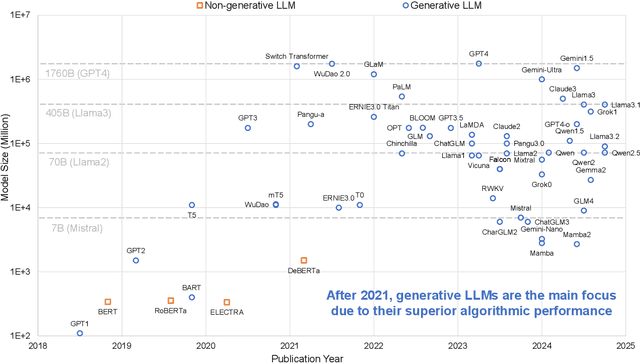

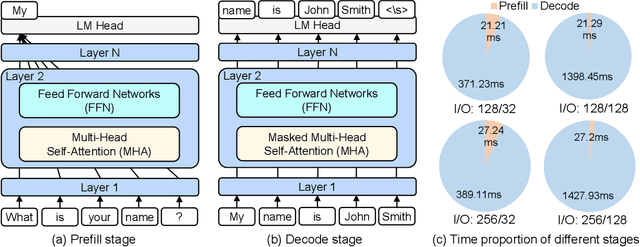
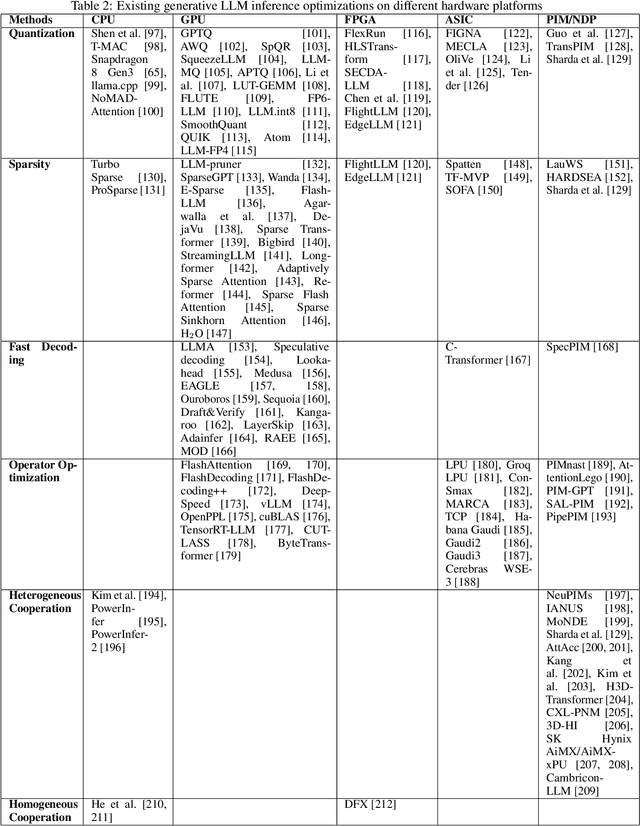
Abstract:Large Language Models (LLMs) have demonstrated remarkable capabilities across various fields, from natural language understanding to text generation. Compared to non-generative LLMs like BERT and DeBERTa, generative LLMs like GPT series and Llama series are currently the main focus due to their superior algorithmic performance. The advancements in generative LLMs are closely intertwined with the development of hardware capabilities. Various hardware platforms exhibit distinct hardware characteristics, which can help improve LLM inference performance. Therefore, this paper comprehensively surveys efficient generative LLM inference on different hardware platforms. First, we provide an overview of the algorithm architecture of mainstream generative LLMs and delve into the inference process. Then, we summarize different optimization methods for different platforms such as CPU, GPU, FPGA, ASIC, and PIM/NDP, and provide inference results for generative LLMs. Furthermore, we perform a qualitative and quantitative comparison of inference performance with batch sizes 1 and 8 on different hardware platforms by considering hardware power consumption, absolute inference speed (tokens/s), and energy efficiency (tokens/J). We compare the performance of the same optimization methods across different hardware platforms, the performance across different hardware platforms, and the performance of different methods on the same hardware platform. This provides a systematic and comprehensive summary of existing inference acceleration work by integrating software optimization methods and hardware platforms, which can point to the future trends and potential developments of generative LLMs and hardware technology for edge-side scenarios.
MARCA: Mamba Accelerator with ReConfigurable Architecture
Sep 16, 2024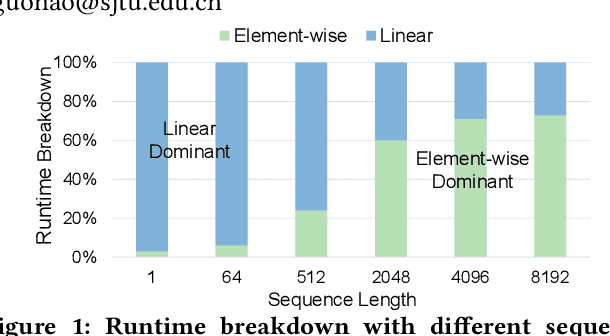


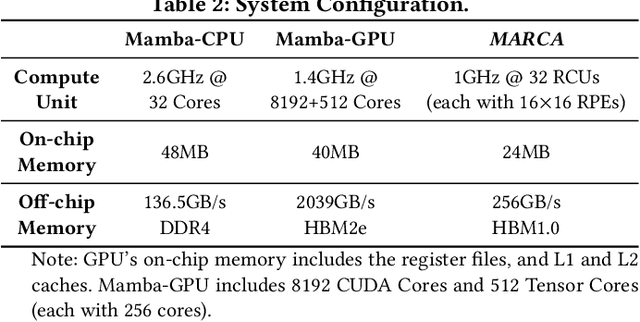
Abstract:We propose a Mamba accelerator with reconfigurable architecture, MARCA.We propose three novel approaches in this paper. (1) Reduction alternative PE array architecture for both linear and element-wise operations. For linear operations, the reduction tree connected to PE arrays is enabled and executes the reduction operation. For element-wise operations, the reduction tree is disabled and the output bypasses. (2) Reusable nonlinear function unit based on the reconfigurable PE. We decompose the exponential function into element-wise operations and a shift operation by a fast biased exponential algorithm, and the activation function (SiLU) into a range detection and element-wise operations by a piecewise approximation algorithm. Thus, the reconfigurable PEs are reused to execute nonlinear functions with negligible accuracy loss.(3) Intra-operation and inter-operation buffer management strategy. We propose intra-operation buffer management strategy to maximize input data sharing for linear operations within operations, and inter-operation strategy for element-wise operations between operations. We conduct extensive experiments on Mamba model families with different sizes.MARCA achieves up to 463.22$\times$/11.66$\times$ speedup and up to 9761.42$\times$/242.52$\times$ energy efficiency compared to Intel Xeon 8358P CPU and NVIDIA Tesla A100 GPU implementations, respectively.
Collaborative Learning with Shared Linear Representations: Statistical Rates and Optimal Algorithms
Sep 07, 2024Abstract:Collaborative learning enables multiple clients to learn shared feature representations across local data distributions, with the goal of improving model performance and reducing overall sample complexity. While empirical evidence shows the success of collaborative learning, a theoretical understanding of the optimal statistical rate remains lacking, even in linear settings. In this paper, we identify the optimal statistical rate when clients share a common low-dimensional linear representation. Specifically, we design a spectral estimator with local averaging that approximates the optimal solution to the least squares problem. We establish a minimax lower bound to demonstrate that our estimator achieves the optimal error rate. Notably, the optimal rate reveals two distinct phases. In typical cases, our rate matches the standard rate based on the parameter counting of the linear representation. However, a statistical penalty arises in collaborative learning when there are too many clients or when local datasets are relatively small. Furthermore, our results, unlike existing ones, show that, at a system level, collaboration always reduces overall sample complexity compared to independent client learning. In addition, at an individual level, we provide a more precise characterization of when collaboration benefits a client in transfer learning and private fine-tuning.
A Survey on Efficient Inference for Large Language Models
Apr 22, 2024Abstract:Large Language Models (LLMs) have attracted extensive attention due to their remarkable performance across various tasks. However, the substantial computational and memory requirements of LLM inference pose challenges for deployment in resource-constrained scenarios. Efforts within the field have been directed towards developing techniques aimed at enhancing the efficiency of LLM inference. This paper presents a comprehensive survey of the existing literature on efficient LLM inference. We start by analyzing the primary causes of the inefficient LLM inference, i.e., the large model size, the quadratic-complexity attention operation, and the auto-regressive decoding approach. Then, we introduce a comprehensive taxonomy that organizes the current literature into data-level, model-level, and system-level optimization. Moreover, the paper includes comparative experiments on representative methods within critical sub-fields to provide quantitative insights. Last but not least, we provide some knowledge summary and discuss future research directions.
Enabling Fast 2-bit LLM on GPUs: Memory Alignment, Sparse Outlier, and Asynchronous Dequantization
Nov 28, 2023Abstract:Large language models (LLMs) have demonstrated impressive abilities in various domains while the inference cost is expensive. The state-of-the-art methods use 2-bit quantization for mainstream LLMs. However, challenges still exist: (1) Nonnegligible accuracy loss for 2-bit quantization. Weights are quantized by groups, while the ranges of weights are large in some groups, resulting in large quantization errors and nonnegligible accuracy loss (e.g. >3% for Llama2-7b with 2-bit quantization in GPTQ and Greenbit). (2) Limited accuracy improvement by adding 4-bit weights. Increasing 10% extra average bit more 4-bit weights only leads to <0.5% accuracy improvement on a quantized Llama2-7b. (3) Time-consuming dequantization operations on GPUs. The dequantization operations lead to >50% execution time, hindering the potential of reducing LLM inference cost. To tackle these challenges, we propose the following techniques: (1) We only quantize a small fraction of groups with the larger range using 4-bit with memory alignment consideration on GPUs. (2) We point out that the distribution of the sparse outliers with larger weights is different in 2-bit and 4-bit groups, and only a small fraction of outliers require 16-bit quantization. Such design leads to >0.5% accuracy improvement with <3% average increased bit for Llama2-7b. (3) We design the asynchronous dequantization on GPUs, leading to up to 3.92X speedup. We conduct extensive experiments on different model families and model sizes. We achieve 2.85-bit for each weight and the end-to-end speedup for Llama2-7b is 1.74X over the original model, and we reduce both runtime cost and hardware cost by up to 2.70X and 2.81X with less GPU requirements.
FlashDecoding++: Faster Large Language Model Inference on GPUs
Nov 10, 2023



Abstract:As the Large Language Model (LLM) becomes increasingly important in various domains. However, the following challenges still remain unsolved in accelerating LLM inference: (1) Synchronized partial softmax update. The softmax operation requires a synchronized update operation among each partial softmax result, leading to ~20% overheads for the attention computation in LLMs. (2) Under-utilized computation of flat GEMM. The shape of matrices performing GEMM in LLM inference is flat, leading to under-utilized computation and >50% performance loss after padding zeros in previous designs. (3) Performance loss due to static dataflow. Kernel performance in LLM depends on varied input data features, hardware configurations, etc. A single and static dataflow may lead to a 50.25% performance loss for GEMMs of different shapes in LLM inference. We present FlashDecoding++, a fast LLM inference engine supporting mainstream LLMs and hardware back-ends. To tackle the above challenges, FlashDecoding++ creatively proposes: (1) Asynchronized softmax with unified max value. FlashDecoding++ introduces a unified max value technique for different partial softmax computations to avoid synchronization. (2) Flat GEMM optimization with double buffering. FlashDecoding++ points out that flat GEMMs with different shapes face varied bottlenecks. Then, techniques like double buffering are introduced. (3) Heuristic dataflow with hardware resource adaptation. FlashDecoding++ heuristically optimizes dataflow using different hardware resource considering input dynamics. Due to the versatility of optimizations in FlashDecoding++, FlashDecoding++ can achieve up to 4.86x and 2.18x speedup on both NVIDIA and AMD GPUs compared to Hugging Face implementations. FlashDecoding++ also achieves an average speedup of 1.37x compared to state-of-the-art LLM inference engines on mainstream LLMs.
Federated Learning in the Presence of Adversarial Client Unavailability
May 31, 2023Abstract:Federated learning is a decentralized machine learning framework wherein not all clients are able to participate in each round. An emerging line of research is devoted to tackling arbitrary client unavailability. Existing theoretical analysis imposes restrictive structural assumptions on the unavailability patterns, and their proposed algorithms were tailored to those assumptions. In this paper, we relax those assumptions and consider adversarial client unavailability. To quantify the degrees of client unavailability, we use the notion of {\em $\epsilon$-adversary dropout fraction}. For both non-convex and strongly-convex global objectives, we show that simple variants of FedAvg or FedProx, albeit completely agnostic to $\epsilon$, converge to an estimation error on the order of $\epsilon (G^2 + \sigma^2)$, where $G$ is a heterogeneity parameter and $\sigma^2$ is the noise level. We prove that this estimation error is minimax-optimal. We also show that the variants of FedAvg or FedProx have convergence speeds $O(1/\sqrt{T})$ for non-convex objectives and $O(1/T)$ for strongly-convex objectives, both of which are the best possible for any first-order method that only has access to noisy gradients. Our proofs build upon a tight analysis of the selection bias that persists in the entire learning process. We validate our theoretical prediction through numerical experiments on synthetic and real-world datasets.
 Add to Chrome
Add to Chrome Add to Firefox
Add to Firefox Add to Edge
Add to Edge